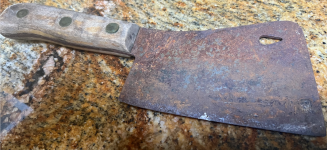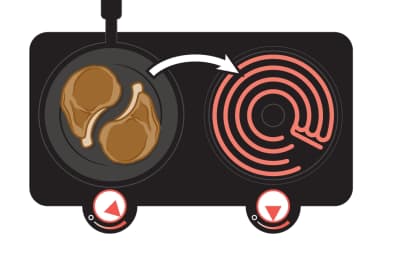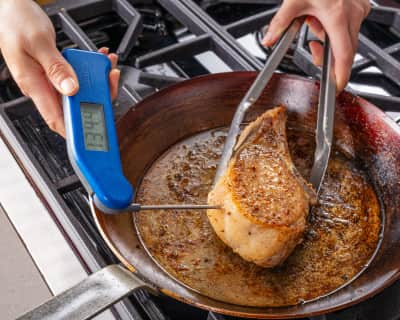Really.
And this coming from someone who literally sucks at cooking meat.
Per the Jan-Feb 2022 CI magazine, it's the method that's the key: starting out in a cold pan and flipping every 2 minutes, starting at high heat for the first 2 flips, then over to a med heat burner.
First up: buy the right kind of pork chop. They call for a RIB CHOP with a large loin section and specify 1.5" thickness. I bought my chops at Whole Foods and tried a 1.5" ($7.99/lb) the first time (it must have been a pound chop because the price was $7.99) and a 1" (on sale for $5.99) the second time, as they had no 1.5" left. Both worked with this method.
Second, they recommend either a non-stick pan or a carbon-steel pan. I don't know what the second one means, but I checked and my all-clad are not carbon steel, so I used T-Fal non-stick.
Third, if you have time, sprinkle 3/4 tsp Diamond Kosher salt (not Morton) on each chop, refrigerate for 1 hour, then blot moisture off before cooking. I did and think it helps.
Two 1.5" (14-16 oz) rib chops
1/2 tsp black pepper
Sprinkle black pepper on dried chops.
Add your chop(s) to the cold pan, rotating their bone structure so they nest together like yin/yang symbol. But not touching.
Turn heat to high and set timer for 2 minutes.
Turn another burner to medium heat.
Turn at the 2 minute mark and set timer for 2 minutes.
At the mark, flip the chops, switch the pan to the lower temperature burner and continue the 2 minute flip process for 10-15 minutes. As you get near the end time, pan should be sizzling. If not, increase heat slightly. If pan is smoking, reduce heat. Remove when interior tests 140 degrees. Transfer to carving board and let rest for 5 minutes. Season with sea salt if necessary.
Marilyn's Notes:
I did the pre-salting.
My first 1.5" chop took 16 minutes to reach 140 degrees, holding the chop with tongs and inserting my Thermapen in through the side of the chop. Avoid the bone. The 1" chop only took 12 minutes. Both exuded a wonder juice that I poured over the slices.
Also, I have an electric (ugh) stove, which is why I'm talking about using two different burners. Lucky people with gas stoves can just reduce from high heat to medium heat.
And this coming from someone who literally sucks at cooking meat.
Per the Jan-Feb 2022 CI magazine, it's the method that's the key: starting out in a cold pan and flipping every 2 minutes, starting at high heat for the first 2 flips, then over to a med heat burner.
First up: buy the right kind of pork chop. They call for a RIB CHOP with a large loin section and specify 1.5" thickness. I bought my chops at Whole Foods and tried a 1.5" ($7.99/lb) the first time (it must have been a pound chop because the price was $7.99) and a 1" (on sale for $5.99) the second time, as they had no 1.5" left. Both worked with this method.
Second, they recommend either a non-stick pan or a carbon-steel pan. I don't know what the second one means, but I checked and my all-clad are not carbon steel, so I used T-Fal non-stick.
Third, if you have time, sprinkle 3/4 tsp Diamond Kosher salt (not Morton) on each chop, refrigerate for 1 hour, then blot moisture off before cooking. I did and think it helps.
Two 1.5" (14-16 oz) rib chops
1/2 tsp black pepper
Sprinkle black pepper on dried chops.
Add your chop(s) to the cold pan, rotating their bone structure so they nest together like yin/yang symbol. But not touching.
Turn heat to high and set timer for 2 minutes.
Turn another burner to medium heat.
Turn at the 2 minute mark and set timer for 2 minutes.
At the mark, flip the chops, switch the pan to the lower temperature burner and continue the 2 minute flip process for 10-15 minutes. As you get near the end time, pan should be sizzling. If not, increase heat slightly. If pan is smoking, reduce heat. Remove when interior tests 140 degrees. Transfer to carving board and let rest for 5 minutes. Season with sea salt if necessary.
Marilyn's Notes:
I did the pre-salting.
My first 1.5" chop took 16 minutes to reach 140 degrees, holding the chop with tongs and inserting my Thermapen in through the side of the chop. Avoid the bone. The 1" chop only took 12 minutes. Both exuded a wonder juice that I poured over the slices.
Also, I have an electric (ugh) stove, which is why I'm talking about using two different burners. Lucky people with gas stoves can just reduce from high heat to medium heat.
Last edited:





